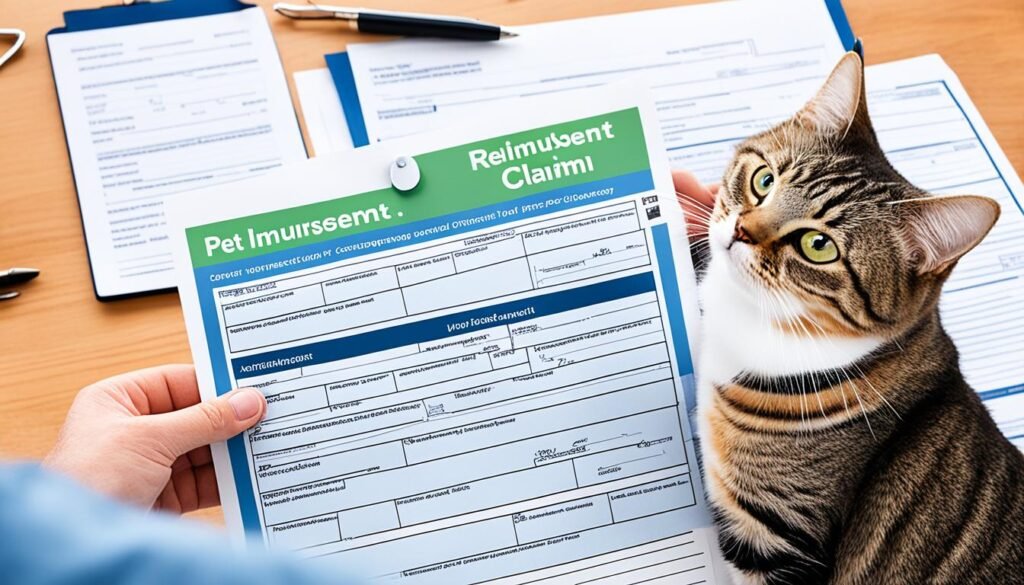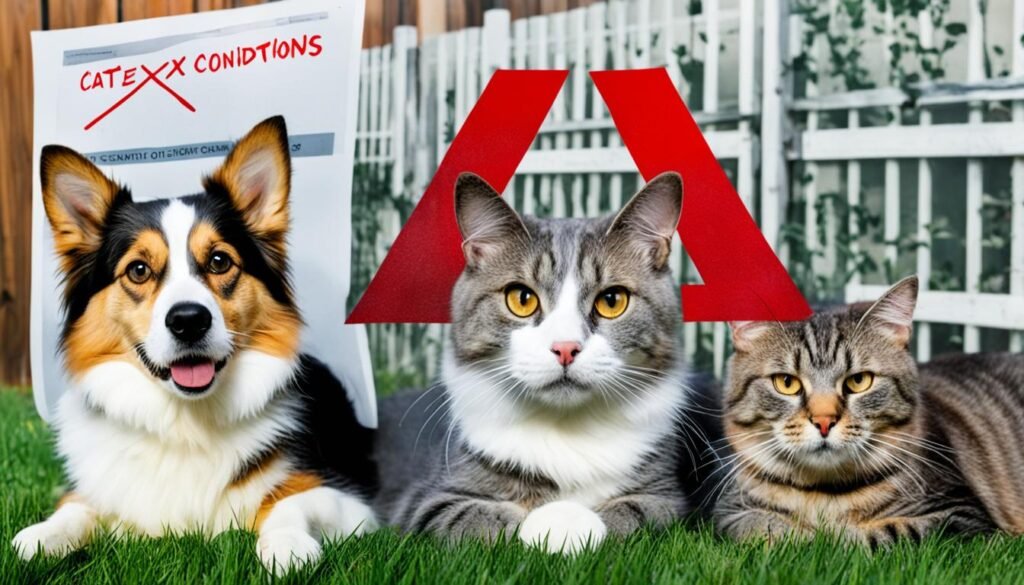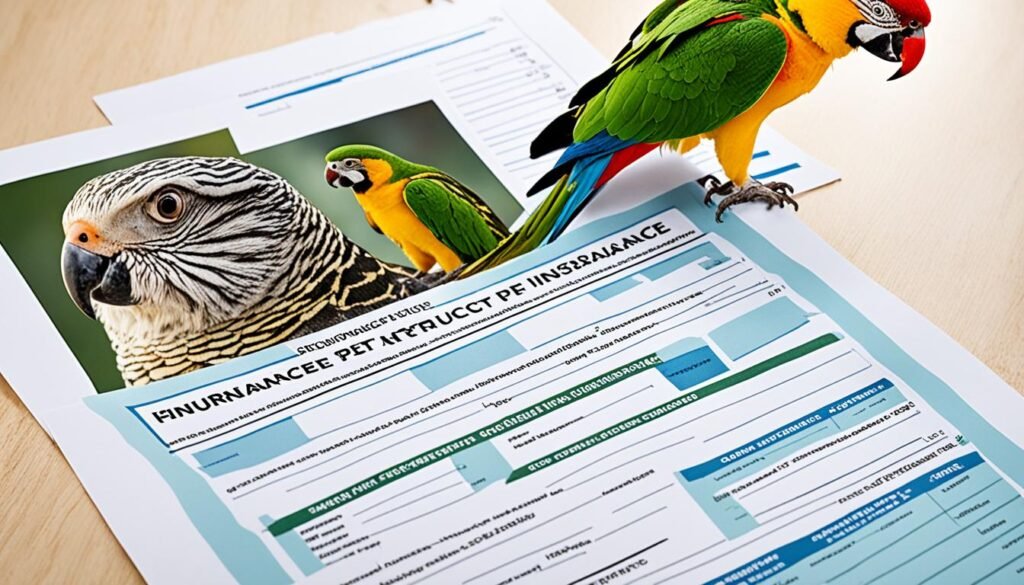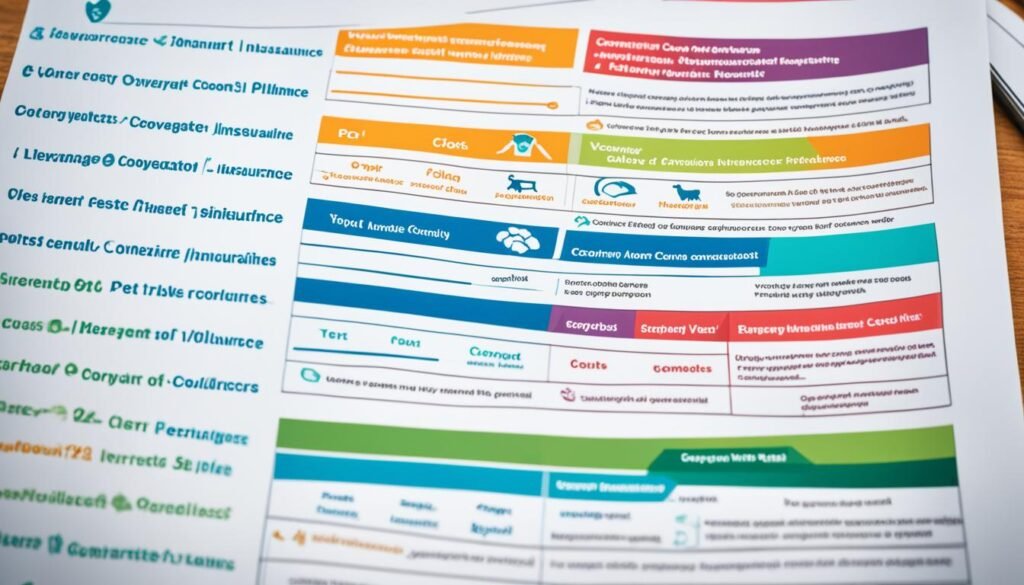In 2022, the number of insured pets in the US reached 5.36 million. This was an increase from 4.4 million in 2021. 80.1% of these pets were dogs and 19.9% were cats. Many owners chose comprehensive plans for their pets. 92.8% of the insured pets had coverage for accidents, illnesses, or wellness.
Key Takeaways: Pet Insurance Work
- The number of insured pets in the US has increased significantly in recent years.
- Most pet owners opt for comprehensive accident and illness or wellness plans.
- Pet insurance provides financial protection for unexpected veterinary expenses.
- Understanding the reimbursement process and policy details is crucial when choosing a plan.
- Pet insurance can help ensure your furry friend receives the best possible care.
What is Pet Insurance?
Pet insurance helps pet owners pay for the cost of their pet’s health care. It is like human health insurance but for pets. Pet owners pay a premium monthly or yearly. In return, they get money back for certain vet expenses.
Definition and Overview of Pet Insurance
Pet insurance is there to cover your pet’s medical needs. This includes accident, illness, and routine health care. When your pet needs to see a vet, you pay the full cost first. Then, you can file a claim. Your insurance provider will pay you back for some of the costs.
Types of Pet Insurance Plans
There are many kinds of pet insurance plans. Each one offers different coverage and features. The main ones are:
- Accident-only plan: For unexpected injuries like fractures, cuts, or eating something bad.
- Accident and illness plan: Helps with both unplanned injuries and illnesses, including serious conditions like cancer.
- Routine wellness plan: For regular checkups, shots, and teeth cleaning to keep your pet healthy.
Don’t forget, the exact things each plan covers and how much they give back can change. Pet owners should look at different plans carefully. Then they can choose one that meets their pet’s needs and their wallet.
Knowing about the different pet insurance options helps pet owners pick what’s best for their pets. It ensures their furry friends get the care they need without any financial worries.
Also Read :What Is An Installment Loan?
How Pet Insurance Works

Figuring out pet insurance can seem tricky, but it’s all about knowing how you get money back. Understanding deductibles and what rate your insurer pays is crucial. This info helps you choose the best insurance for your pet.
Reimbursement Process
With pet insurance, you pay the vet bill first. Then you ask your insurance to give you back some of that money. They check your claim and return money for things they cover.
If your insurer works with vets directly, like Trupanion, they might pay the vet directly. This means you only pay for what’s not covered.
Deductibles and Reimbursement Rates
Deductibles and how much your insurer pays you back are big parts of pet insurance. A deductible is what you owe before your insurance helps. If you choose a higher deductible, you pay less monthly but more at the vet’s.
What you get back from your insurer depends on the plan. If they have an 80% reimbursement rate, they cover 80% of the costs. You pay the rest.
Knowing your plan’s deductible and reimbursement rate is key. It helps you plan and afford your pet’s care.
“Understanding how claims and costs work can help pet owners get the most from their insurance.”
Also Read : What Is A Loan Disbursement?
Where Can You Use Pet Insurance?

You can use pet insurance almost anywhere that has a license. This includes your vet, specialists, or emergency clinics. Unlike our own health insurance, pet insurance is not tied to specific doctors. So go ahead and choose the best care for your pet without network worries.
But, check the fine print first. Some insurance may need vets to follow certain rules for you to get money back. It’s smart to look at your policy and what the company needs before you see the vet.
Pet insurance gives you the freedom to choose where your pet gets care. This can be your regular vet, a specialist, or an emergency clinic. Your insurance covers you no matter where you go, ensuring your pet gets the best care.
| Where to Use Pet Insurance | Pet Insurance Provider Network | Pet Insurance Coverage at Any Vet |
|---|---|---|
| Any licensed veterinarian, specialist, or emergency clinic | No restrictive provider networks | Coverage typically follows you to any licensed veterinary facility |
Being able to use pet insurance at any vet is great news for pet owners. It means you can focus on your pet’s health without financial stress over vet choices.
“One of the best things about pet insurance is the flexibility it provides in terms of where you can take your pet for medical care. You’re not limited to a specific network, which means you can choose the veterinarian that’s best for your pet’s needs.”
Also Read :How Do I Get A Loan Without Credit?
What Does Pet Insurance Cover?

Pet insurance varies based on the plan you pick. It’s key to know what it usually includes. This way, you can choose the best plan for your pet.
Accidents and Illnesses
Most good pet insurance plans cover accidents and sicknesses. They pay for vet bills from things like swallowing objects, animal bites, broken bones, and lacerations. They also help with costs from illnesses like allergies, cancer, hereditary conditions, and arthritis.
Breed-Specific Conditions and Pre-Existing Conditions
Some plans cover conditions that are common in your pet’s type. But, it’s key to remember pre-existing conditions are usually not included. This means if your pet was sick before you got insurance, those issues won’t be covered.
Some pet insurance plans also offer routine care or wellness coverage. This might cover things like annual checkups, dental cleanings, vaccinations, and spaying or neutering. By knowing what each plan offers, you can find the best fit for your pet’s needs and your budget.
“Investing in pet insurance can provide peace of mind and financial protection for your beloved companion in the event of unexpected medical emergencies or chronic conditions.”
Also Read : How Does Insurance Protect Against Natural Disasters?
Pet Insurance Work

For pet owners, knowing how to claim pet insurance is key. If you follow the ASPCA® Pet Health Insurance’s steps, it’s pretty easy.
- Schedule a vet appointment and pay for the veterinarian bills entirely.
- Then, file a claim. Do this online or using the pet insurer’s app. Be sure to attach the bill copy.
- After your claim is okayed, you’ll get your money back. This can be through direct deposit or a check sent via mail.
Pet insurance reimbursement offers peace of mind and financial support. Submitting a claim means you can get some money back from your pet’s vet expenses. This helps make how pet insurance works clearer.
The pet insurance claims process may need some extra steps. For instance, you must give detailed medical records and stick to the insurer’s rules. Knowing what to do makes claiming smoother, getting your money back faster.
“Understanding the pet insurance claims process is key for pet owners. It helps get the most out of your coverage. Plus, it ensures your pets get the excellent care they need.”
Getting through the pet insurance reimbursement process well lets you concentrate on your pet’s care. This makes caring for your pet a stress-free and joyful experience for both of you.
Also Read :Best MBA Scholarship Programs In Canada
What Does Pet Insurance Not Cover?

Understanding what pet insurance does not cover is key. While it does protect your pet in many ways, it comes with some rules. Knowing these can help manage your expectations.
Exclusions and Limitations
One big rule is about pre-existing conditions. These are health issues your pet had before getting the insurance. Usually, they’re not covered. This is because they’re seen as too risky for the insurer.
Also, don’t expect pet insurance to handle regular pet care. Things like yearly shots, checking for fleas, or a simple vet visit are not typically included. For this, you might need an extra plan alongside your basic insurance.
- Breeding, pregnancy, and birth-related conditions
- Cosmetic procedures, such as nail trimming or teeth cleaning
- DNA testing or genetic screening
- Accidents or illnesses caused by fighting, racing, cruelty, or neglect
- Elective procedures, such as declawing or ear cropping
- Experimental treatments or therapies
- Everyday costs of pet ownership, such as food, toys, grooming, and boarding
Before buying pet insurance, read through what it covers and excludes. This step can save you a lot of stress later on. Being well-informed means you can better plan for your pet’s care.
Always remember: pet insurance takes care of the unexpected. It’s not meant for the regular, day-to-day pet bills. Understanding these points will help you decide wisely for your pet and budget.
Does Pet Insurance Cover Other Pets?

Most pet insurance plans focus on dogs and cats. Yet, some insurers will cover a wider variety of pets, even including horses. If your pet is not a standard dog or cat, you should look into different insurance plans. This will help make sure they get the care they need.
Pet insurance coverage for other pets is offered by few providers, like Nationwide. They have a special plan for birds, reptiles, and small mammals. This plan includes creatures like ferrets, guinea pigs, and chinchillas. It can pay for vet visits and treatments, taking some of the financial burden off your shoulders.
ASPCA stands out for offering pet insurance for horses. Their plan covers many horse-related needs, such as injuries and routine health care. Horse owners who depend on their animals for sports or work find this type of insurance very beneficial. It ensures their horses’ health costs are taken care of.
“With the right pet insurance coverage, owners of exotic animals and horses can have peace of mind knowing their beloved pets are protected, even if they require specialized medical attention.”
Remember, the kinds of insurance for less common pets and the coverage details can change based on the insurer and where you live. It’s always smart to do a lot of research and fully understand the policy before making a decision. This way, you ensure your pet gets the best care possible.
How Much Does Pet Insurance Cost?

The cost of pet insurance can vary a lot. This is because many factors affect the premiums. By understanding these factors, you can choose the best insurance for your pet wisely.
Factors Affecting Pet Insurance Premiums
Several things affect how much you pay for pet insurance each month or year:
- Your pet’s age, breed, and species – Older pets and certain breeds, including exotic animals, usually have higher premiums.
- The type of coverage – Plans that cover accidents only are cheaper than those covering accidents, illness, and wellness.
- The deductible amount – A plan with a higher deductible will cost less each month.
- The reimbursement percentage – If the plan pays back more, like 90%, the premiums are higher compared to plans with 80% or 70% reimbursement.
- The annual coverage limit – A plan with a higher limit costs more than one with a lower limit.
- Your pet’s location – The cost of veterinary care in your region affects how much you pay for insurance.
| Factors | Impact on Premiums |
|---|---|
| Pet’s Age | Older pets have higher premiums |
| Pet’s Breed | Certain breeds have higher premiums |
| Type of Coverage | Comprehensive plans have higher premiums |
| Deductible Amount | Higher deductibles have lower premiums |
| Reimbursement Percentage | Higher reimbursement rates have higher premiums |
| Annual Coverage Limit | Higher limits have higher premiums |
| Pet’s Location | Areas with higher veterinary costs have higher premiums |
Knowing these factors helps you understand pet insurance costs better. It lets you choose a plan that meets your pet’s needs within your budget.
Choosing the Right Pet Insurance Plan

Choosing the right pet insurance is very important for your pet’s health. There are many plans to pick from. Look at the big things to choose well for your pet and your wallet.
To choose the best pet insurance plan, look at several important things:
- Type of coverage: Accident-only, accident and illness, or accident and illness with wellness.
- Deductible amount: The amount you’ll pay out-of-pocket before the insurance coverage kicks in.
- Reimbursement percentage: The portion of the veterinary costs that the insurance plan will cover.
- Annual coverage limit: The maximum amount the plan will pay out per year.
- Monthly premium cost: The amount you’ll pay each month for the insurance plan.
- Waiting periods: The time frame before your pet’s coverage for accidents and illnesses begins.
- Coverage for breed-specific conditions and pre-existing conditions.
When comparing pet insurance plans, always check the details. Know what each plan covers and what it doesn’t. This makes sure you choose the right plan for your pet and your budget.
The best pet insurance plan for you and your pet will depend on what you prefer. By carefully looking at the factors to consider when buying pet insurance, you can choose the best plan. This will give the right protection and peace of mind for your pet.
“The right pet insurance plan can make all the difference in providing your pet with the care they deserve.”
Also Read : Can I Get An Upgrade Loan For Home Improvements?
Conclusion
Pet insurance is a great way to protect your pet’s health. It covers part of the cost for vet visits. This includes the process of reimbursement, deductibles, and what it covers.
It does not cover health problems your pet already had before getting the insurance. But it helps with the costs of sudden sicknesses, accidents, and those issues some breeds have. This is very helpful because vet bills are increasing.
To sum it up, pet insurance is smart for those who care about their pets a lot. It helps with sudden health costs and avoids a big bill shock. Knowing how pet insurance works helps pet owners choose wisely.
FAQs
What is pet insurance?
Pet insurance helps with your furry friend’s medical costs. You pay a monthly or yearly fee. Then, if your pet needs the vet for a covered issue, you get some of the money back. This money comes from the insurance company, not your pocket directly.
What types of pet insurance plans are available?
There are a few kinds of pet insurance. Some plans just cover accidents. Others are more comprehensive, covering both accidents and sicknesses. You can also find plans that help with routine check-ups and preventive care.
How does the pet insurance reimbursement process work?
You can visit any licensed vet with your pet insurance. After your pet’s treatment, you pay the vet first. Then, you submit a claim to your insurance. They will review it and return some money to you for the expenses that they cover.
What does pet insurance typically cover?
Pet insurance can take care of many vet bills. This includes accidents, any illnesses, and sometimes regular check-ups. But things like pre-existing conditions, having babies, and optional surgeries are usually not covered.
How does the pet insurance claims process work?
Making a claim is usually easy. You take your pet to the vet, pay the vet bill, and send the information to your insurance online or through their app. After they look at your claim and approve, they send a payment back to you.
What types of pets can be covered by insurance?
Typically, pet insurance covers cats and dogs. But, companies like Nationwide also insure other fun pets like guinea pigs, birds, and even horses.
How much does pet insurance cost?
The price of pet insurance changes depending on a lot of things. This includes your pet’s age, what breed they are, how much coverage you want, and which state you’re in. Other factors like the deductible and how much you can get back also play a role.
What should I consider when choosing a pet insurance plan?
When picking a pet insurance, think about what is covered and what is not. Check the deductible (the money you pay first), how much will be repaid, and yearly limits. Think about how long you might wait for coverage on specific conditions too.
Source Links
- https://www.aspcapetinsurance.com/research-and-compare/pet-insurance-basics/how-does-pet-insurance-work/
- https://www.pawlicy.com/blog/what-is-pet-insurance/
- https://www.usnews.com/insurance/pet-insurance/what-is-pet-insurance




